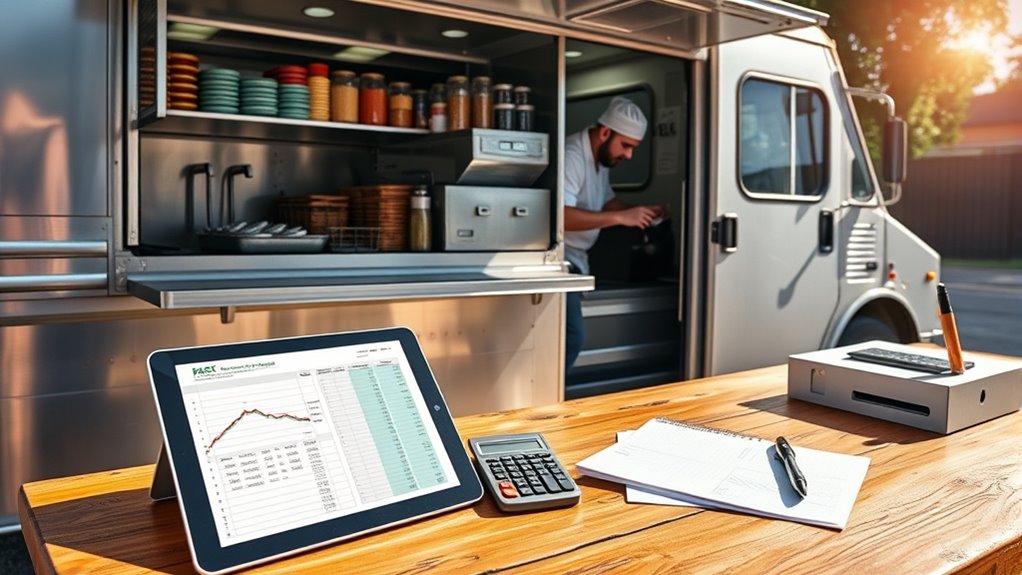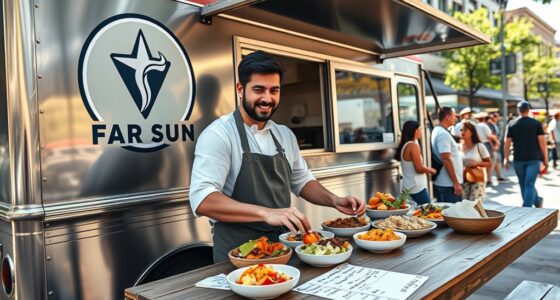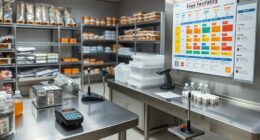To calculate your food truck start-up costs, you need to add up expenses like buying or leasing the vehicle, customizing it with necessary equipment, obtaining permits and insurance, and designing branding and marketing materials. Don’t forget to include costs for POS systems, staffing, and ongoing supplies, plus a thorough fund for surprises. Taking a full approach helps you plan accurately—if you keep exploring, you’ll discover how to budget effectively for your new venture.
Key Takeaways
- Include vehicle purchase price, customization, and essential equipment in initial cost estimates.
- Budget for permits, licenses, insurance, and legal compliance expenses.
- Calculate inventory, supplies, and storage costs based on menu and operational needs.
- Factor in branding, marketing, and technology investments like POS systems.
- Allocate funds for staffing, training, contingency reserves, and ongoing operational expenses.
Purchasing the Food Truck

Purchasing the food truck is a significant upfront cost that sets your business in motion. When choosing your truck, consider not only the purchase price but also ongoing expenses like vehicle maintenance and fuel costs. A reliable truck minimizes repairs, saving you money and reducing downtime. Keep in mind that fuel expenses can fluctuate based on your routes and operating hours, so selecting a fuel-efficient vehicle can help control costs. Investing in automation technologies or efficient logistics planning can further streamline your operations and reduce overhead. You might find that investing a little more upfront in a well-maintained, efficient vehicle pays off in the long run. Remember, your truck is the foundation of your business, so weigh options carefully to balance initial costs with future expenses. Proper planning now ensures smoother operations and better profitability later.
Customizing and Outfitting the Truck

Once you’ve selected the right truck, the next step is customizing and outfitting it to match your food concept. Focus on menu customization to guarantee your kitchen setup supports your dishes efficiently. This includes installing specialized equipment like fryers, grills, or refrigeration units tailored to your menu. Interior design also plays an essential role: you want a layout that maximizes space, streamlines workflow, and creates a professional appearance. Consider how cabinetry, shelving, and signage will enhance functionality and brand identity. Don’t forget lighting and ventilation systems to guarantee safety and comfort. Properly customizing and outfitting your truck sets the foundation for smooth operations and a memorable customer experience, so plan carefully to balance practicality with your unique style.
Licensing and Permits
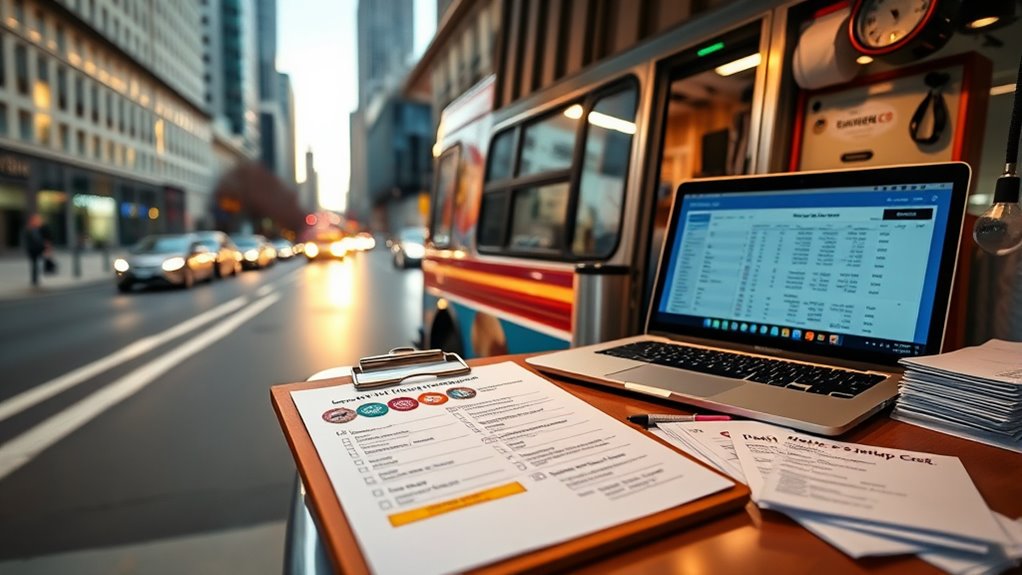
Managing the licensing and permit requirements is a crucial step to operate your food truck legally and avoid costly penalties. You’ll need to obtain permits from your local health department to guarantee food safety standards are met. These permits verify that your truck follows health regulations, including proper sanitation and food handling procedures. Additionally, you may need a mobile food vendor license and other local permits depending on your city or state. Here’s a quick overview:
| Permit Type | Purpose |
|---|---|
| Health Department | Ensures food safety and sanitation compliance |
| Business License | Legitimizes your operation |
| Mobile Food Vendor | Allows on-the-go food service |
| Fire Department | Confirms fire safety measures are in place |
Stay compliant to keep your food truck running smoothly. Proper documentation and adherence to regulations are essential for a successful operation.
Insurance Coverage

Securing the right insurance coverage is a vital step after obtaining your permits, as it protects your food truck, your livelihood, and your customers. Food truck insurance offers various coverage options, including general liability, vehicle coverage, and property protection. These options help safeguard against accidents, property damage, and liability claims. It’s essential to evaluate your specific needs and choose policies that fit your operation’s size and scope. Some providers also offer specialized coverage for food spoilage or equipment breakdown. Getting extensive food truck insurance may seem costly initially, but it provides peace of mind and financial security. Additionally, understanding coverage limits and policy exclusions can prevent surprises in the event of a claim. Shop around for policies that balance affordability with adequate coverage, ensuring you’re protected against unforeseen incidents on the road.
Equipment and Kitchen Supplies
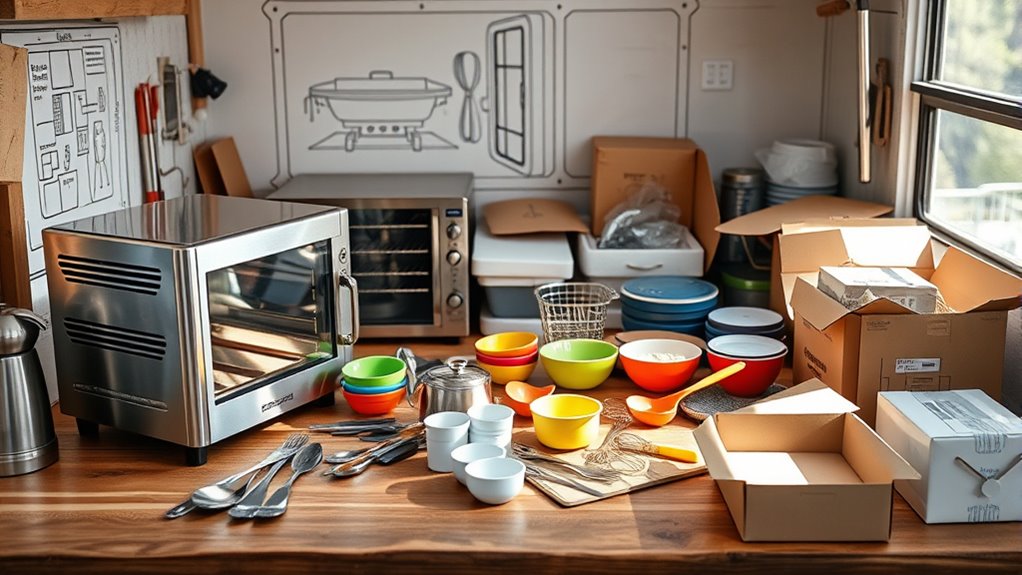
Equipping your food truck with essential kitchen supplies and equipment is crucial for efficient operation and food quality. You’ll need reliable kitchen appliances like grills, fryers, and refrigeration units to prepare and store ingredients safely. Investing in durable storage containers is equally important for organizing ingredients and leftovers, keeping everything fresh and accessible. Consider space-saving appliances that maximize your limited area without sacrificing functionality. High-quality cookware, utensils, and cleaning supplies are also necessary to maintain sanitation and streamline your workflow. Don’t forget to include small gadgets like timers and thermometers to ensure precise cooking. Properly outfitting your truck with these essentials ensures smooth daily operations and helps deliver consistent, high-quality food to your customers. Additionally, incorporating rustic decor elements can enhance the overall aesthetic and appeal of your food truck’s interior.
Initial Food Inventory
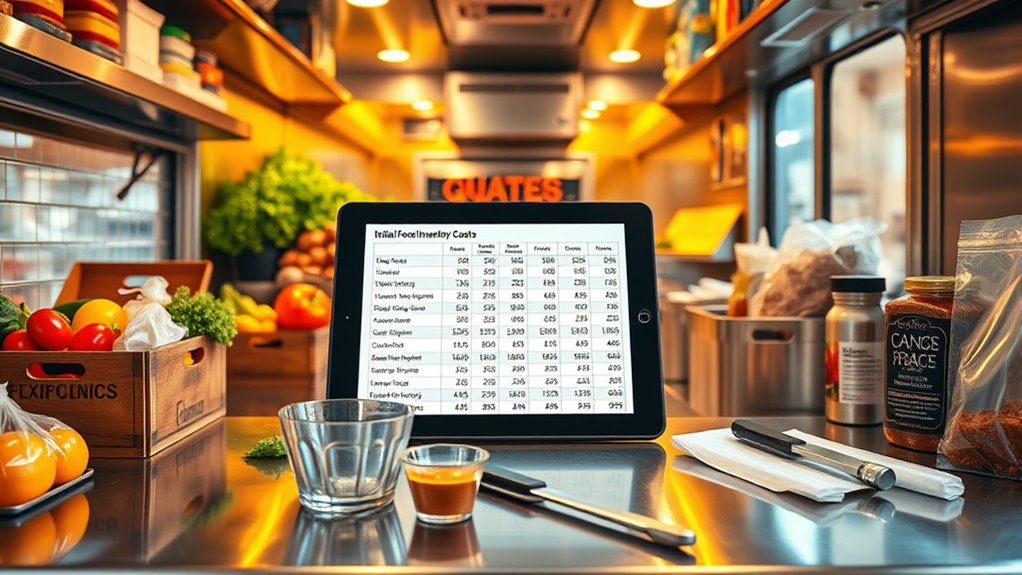
Your initial food inventory is vital for launching your food truck smoothly. You’ll need to create an essential ingredient list to guarantee you have everything on hand for your menu. Getting this right helps you control costs and keeps your operation running efficiently from day one. Incorporating effective wall organization can also help you maximize storage space and maintain a clean, organized environment in your truck.
Initial Food Inventory
Starting with the right initial food inventory is crucial for ensuring your food truck can serve customers from day one. Your menu development guides how much and what ingredients to stock. Focus on essential ingredients for your signature dishes, avoiding overstocking perishable items. During supplier negotiations, aim for competitive prices and reliable delivery schedules to keep costs manageable. Keep track of inventory costs and adjust as needed to balance quality and affordability. Proper planning helps prevent shortages that could delay service or excess waste that cuts into profits. Remember, your initial inventory sets the foundation for smooth operations, so invest time in detailed planning. Additionally, incorporating mindfulness techniques during inventory management can help you stay focused and make more thoughtful purchasing decisions. By aligning your menu with supplier offerings, you’ll start strong and build a sustainable, efficient food truck business.
Essential Ingredient List
An essential ingredient list forms the backbone of your initial food inventory, guaranteeing you can prepare your signature dishes from day one. Start by identifying key ingredients for your recipes, considering how ingredient sourcing impacts costs and availability. Focus on ingredients that define your menu and are versatile enough for multiple dishes. As you develop recipes, refine your list to include only necessary items, avoiding excess inventory that can lead to waste. Accurate recipe development helps determine precise quantities, preventing over-purchasing. Establish relationships with reliable suppliers early to secure quality ingredients at competitive prices. This strategic approach ensures you’re stocked with essential ingredients, streamlining your kitchen operations and setting a solid foundation for your food truck’s success. Incorporating traditional practices can also enhance your menu and connect your offerings to cultural roots, adding value and authenticity.
Branding and Marketing Materials
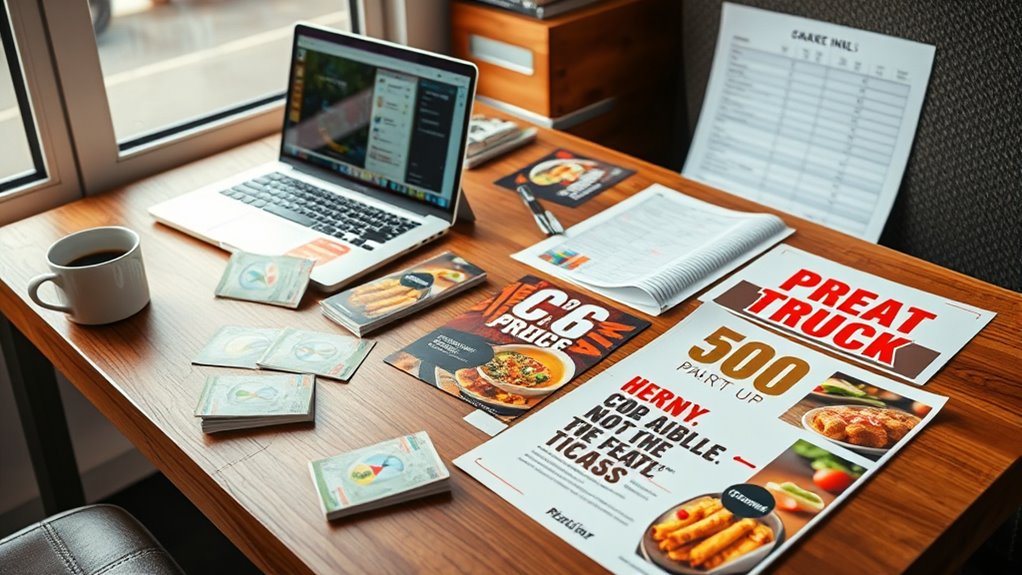
Creating a strong brand identity starts with designing a memorable logo and cohesive visuals. You’ll also need to budget for promotional materials like flyers, banners, and social media ads. These tools help attract customers and build recognition for your food truck. Investing in professional branding materials can further enhance your visual appeal and credibility.
Brand Design and Logo
Designing a memorable brand identity begins with crafting a compelling logo and cohesive marketing materials that reflect your food truck’s personality. Your color palette sets the mood, so choose colors that evoke the feeling you want customers to associate with your brand. Typography choices also play a vital role; select fonts that are clear, attractive, and easy to read from a distance. These elements should work together to create a unified look that stands out on the street and in marketing efforts. Investing in a professional logo ensures your brand looks polished and memorable, which can help attract loyal customers. Keep in mind that consistent branding across all materials reinforces recognition and builds trust over time. Your brand design is a foundational step in establishing your food truck’s identity, and visual branding can significantly impact customer perception and engagement.
Promotional Materials Budget
How much should you budget for promotional materials to effectively market your food truck? Your budget should cover essentials like social media campaigns and printed flyers. Allocating funds for social media ads helps you reach a broad audience and build your brand online. Printed flyers are useful for local events and attracting foot traffic. Consider creating eye-catching designs that reflect your brand identity, which you previously established through your logo. Don’t forget to account for printing costs, design services, and any promotional giveaways. A well-planned promotional materials budget guarantees you’re visible in your community and online, attracting more customers. Keep it flexible to adapt as your marketing needs evolve, but start with a clear estimate based on your overall start-up costs. Additionally, understanding essential oils for branding can inspire creative packaging or promotional giveaways that reinforce your brand identity.
Point of Sale Systems and Technology
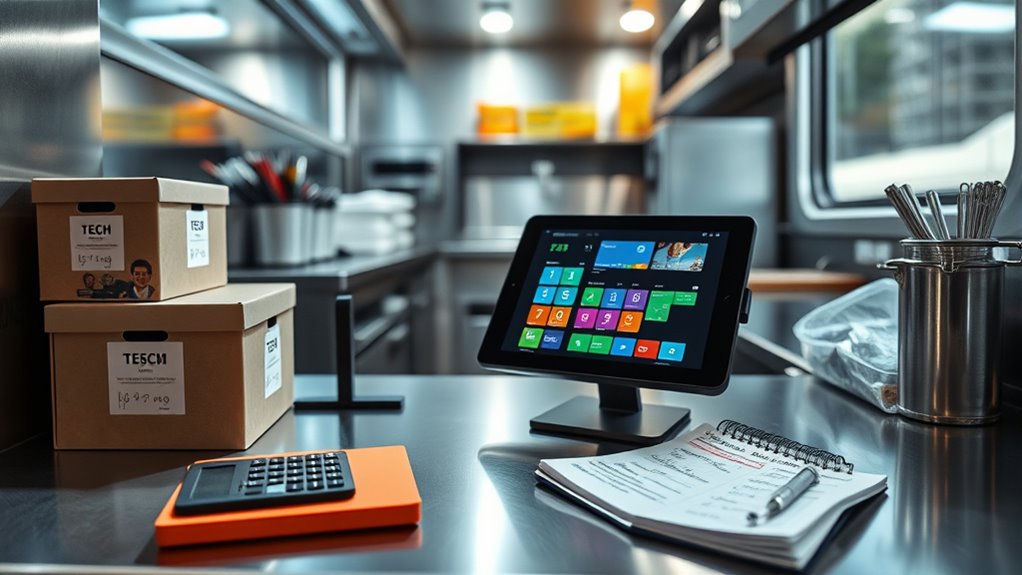
Are you choosing the right point of sale (POS) system for your food truck? A good POS system streamlines your operations, supports mobile payment options, and helps manage inventory efficiently. Look for a system that is portable, easy to use, and compatible with your mobile devices, so you can process orders quickly on the go. Mobile payment capabilities are essential, allowing customers to pay with credit cards, Apple Pay, or Google Pay, speeding up transactions. Additionally, inventory management features help you track stock levels, reduce waste, and plan for restocking. Investing in an adaptable POS system can save you time and money, improve customer experience, and keep your business running smoothly. Choosing the right technology now sets a solid foundation for your food truck’s success. Incorporating reliable home furnishings technology, such as durable and safe devices, can further enhance your setup and ensure long-term operation.
Staff Salaries and Training

When planning your food truck startup, you’ll need to budget for staff wages and benefits to keep your team motivated. Investing in a solid training program guarantees your staff delivers quality service from day one. These expenses are essential for building a reliable team that helps your business succeed. Additionally, understanding the risks associated with merchant services can help you select reliable payment solutions that support your growth.
Staff Wages and Benefits
Staff wages and benefits are vital components of your food truck’s startup costs, as they directly impact daily operations and overall profitability. You’ll need to budget for employee wages, including hourly pay or salaries, and factor in employee benefits like health insurance or paid time off. These benefits can improve staff retention and morale but add to your initial costs. Additionally, consider payroll processing expenses, such as accounting software or hiring a payroll service, to guarantee accurate and timely wage payments. Properly estimating these costs helps prevent surprises later. Keep in mind that competitive wages and benefits can attract skilled staff, which is essential for providing quality service and ensuring your food truck’s success from day one. Incorporating sound healing science concepts, such as creating a positive and harmonious work environment, can also boost employee well-being and productivity.
Training Program Expenses
Investing in a thorough training program is a key step in preparing your staff for success. Training program expenses cover the costs of staff training, ensuring your team understands safety protocols, menu standards, and customer service expectations. These expenses include hiring trainers, developing training materials, and allocating time for staff to learn new skills. Proper staff training reduces errors, improves efficiency, and enhances customer satisfaction. Additionally, calibration techniques can be employed to improve the consistency and accuracy of training outcomes. While training costs might seem significant upfront, they pay off through smoother operations and happier customers. Budgeting for training program expenses upfront helps avoid unexpected costs later. Remember, well-trained staff are essential to your food truck’s reputation and long-term success, making staff training an investment that supports growth and stability.
Contingency and Miscellaneous Expenses

Contingency and miscellaneous expenses are essential to account for unexpected costs that may arise during your food truck startup. Proper contingency planning helps you stay prepared for surprises that can impact your budget. These miscellaneous costs often include unforeseen repairs, permit fees, or last-minute supplies. To make sure you’re covered, consider these common expenses:
- Unexpected vehicle repairs or maintenance
- Additional licensing or permit fees
- Emergency supplies or equipment replacements
- Miscellaneous operational costs, like unexpected marketing needs
- Unexpected expenses can also include costs related to mental wellbeing and maintaining a balanced approach to your business challenges.
Frequently Asked Questions
How Long Does It Typically Take to Start a Food Truck Business?
Starting a food truck business usually takes a few months, depending on your location and preparation. You’ll need to secure food truck permits and licenses, which can take several weeks. Additionally, acquiring and installing mobile kitchen equipment requires planning and scheduling. If you stay organized and start early, you can streamline the process. Typically, expect around 3 to 6 months from planning to launching your mobile kitchen.
What Are the Ongoing Maintenance Costs for a Food Truck?
Imagine you’re cruising in your food truck, but like a vintage radio, regular upkeep is key. Ongoing maintenance costs include vehicle repairs and equipment maintenance, which can vary but generally range from $500 to $1,500 monthly. You’ll need to budget for oil changes, tire replacements, and keeping kitchen appliances in top shape. Staying proactive helps avoid costly breakdowns and keeps your business rolling smoothly on the streets.
How Do Seasonal Changes Affect Food Truck Profitability?
You notice that seasonal demand and weather impacts directly influence your food truck’s profitability. During busy seasons, warmer weather and holidays boost customer traffic, increasing sales. Conversely, colder months or bad weather reduce foot traffic, lowering income. To stay profitable year-round, you should plan for these fluctuations by adjusting your menu, marketing efforts, and operating hours. Staying flexible helps you navigate seasonal demand changes and weather impacts effectively.
What Are the Best Ways to Finance a Food Truck Startup?
Like forging the sword of Hephaestus, you can finance your food truck startup through food truck loans or equipment leasing. These options help you spread the costs and preserve cash flow. Food truck loans provide lump sums, while equipment leasing allows you to access necessary tools without hefty upfront payments. Combining these methods, along with personal savings or investor funding, can turn your culinary dreams into reality efficiently.
How Can I Estimate Potential Revenue and Profit Margins?
To estimate potential revenue and profit margins, start by analyzing your menu pricing based on ingredient costs and competitor prices. Understand your customer demographics to gauge demand and spending habits. Consider factors like location, hours of operation, and target audience. Use sales projections and adjust prices if needed. Monitoring these elements helps you set realistic revenue goals and identify profit margins, ensuring your food truck’s financial success.
Conclusion
Just like Da Vinci planned his masterpieces with precision, calculating your start-up costs guarantees your food truck venture begins smoothly. Every expense, big or small, is a brushstroke toward your success. Stay organized, plan ahead, and don’t forget to leave room for surprises — after all, even the greatest artists knew the importance of a little improvisation. With careful preparation, your food truck can be a work of art on wheels, ready to serve your dreams.
